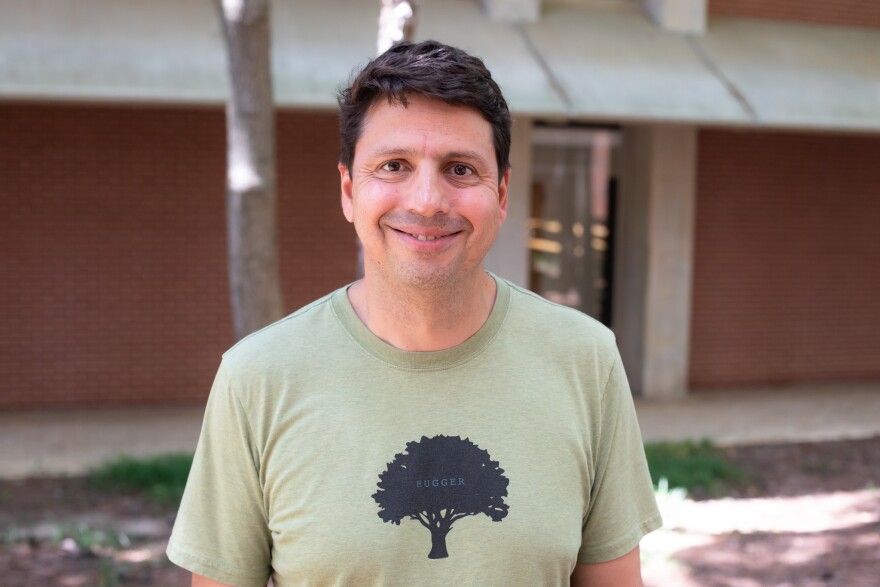Greg Rubino drives his elongated spade, called a sharpshooter, into the decaying organic matter of the Pocosin Lakes National Wildlife Refuge. He’s a wetland scientist with the North Carolina Division of Water Resources, and once he’s dug about a foot underground, past a mat of roots, he reaches into a bed of “real soil” and grabs a sample, crumbling it between his fingers.
Partially decomposed organic matter makes up most of the soil in a pocosin — the acidic soil keeps vegetation from fully decomposing, forming peat.
Globally, peatlands trap and store approximately 550 billion tons of carbon. In this refuge, these swamps also provide vital habitat for many types of fauna, such as deer, black bears, and even the critically endangered red wolf.
Rubino and fellow wetland scientist Kristie Gianopulos are in the refuge on this day to scout potential field sites for their summer wetland assessment project.
The two scientists stand in front of a dense thicket of fetterbush, a wall of vegetation that looms over them like a tunnel trellis.
“I think this is Lyonia lucida,” says Gianopulos, “A typical pocosin evergreen shrub… but I usually don't see it 15-feet high.”

Rubino describes the technique the field scientists employ to reach some sites, demonstrating a terrestrial breaststroke he called “swimming through the bushes.”
A botanist will then identify every plant within the site, looking for changes in composition and coverage from assessments taken six, 10, and, in some cases, 30 years ago. This comparison will show the team how the wetlands are changing over time.
“Today, we are looking at a project site,” says Rubino. “That will help us try to understand how human-induced sea level rise is affecting our wetland fringe in North Carolina on the western side, where the salty, brackish water meets the freshwater zone.”
Although this spot in Tyrrell County is still miles from the coast, a network of ditches that span the coastal plains of North Carolina has played an unexpected role in transporting saltwater further inland. Settlers and farmers dug these ditches, many with slave labor, to drain coastal wetlands to create agricultural land.

“Those ditches were [...] a double whammy for the systems in that they facilitate the movement of salinity from the sound inland,” says Marcelo Ardon, an associate professor at North Carolina State University’s Department of Forestry and Environmental Resources. “And they also lowered the elevation of a lot of these systems.”
By lowering the water table in pocosins, microbes can now completely decompose the peat, condensing the organic foundation of the swamp. Rising tides and lowering ground levels exacerbate the already precarious situation Tyrrell County faces, where 94% of the county’s population lives in low-lying areas at risk of flooding.
Justin Wright, a professor of biology at Duke University, is conducting a complementary survey of coastal wetlands. He recently co-authored a study in which he and a team of researchers discovered a “tipping point” for forested wetland vegetation.

“We didn't know whether all the species would be responding to saltwater in the same way or whether they would all be doing different things,” says Wright. “And it turns out that there are specific saltwater concentrations that are, what we call, ‘tipping points.’ They are places where you see these sudden shifts in community composition.
“When you cross that tipping point, a whole lot of species die off, and other sets of species, the salt-tolerant ones, come in at high levels.”
North Carolina wetlands are incredibly diverse in type and composition — every swamp, bog, or marsh will have its own tipping points. But Wright’s study supports the hypothesis that field researchers can use vegetation to infer sodium levels in the soil and groundwater, which could help direct targeted restoration efforts.
In some instances, brackish or salt marshes may replace freshwater wetlands lost to saltwater intrusion. “I should stress salt marshes are fantastic ecosystems,” said Wright. “It's not like I have anything against salt marshes. And in fact, they're one of the best sources for storing carbon, one of the best ecosystems for doing that on the planet.”
Salt marshes store carbon differently than forested freshwater wetlands, where carbon resides primarily in the trees. In salt marshes, the carbon is captured belowground in the peat. But that process takes time.
“It may be that over 100 or 200 years,” said Wright. “We might be able to bring that carbon back out of the atmosphere. But in the meantime, we're seeing a big burst of carbon going into the atmosphere. And that's what we're concerned about.”
Groups like the Nature Conservancy and the U.S. Fish and Wildlife Service have already begun pocosin restoration projects across the state. Curtis Richardson, director of the Duke University Wetland Center, is evaluating peat’s carbon storage capacity to develop a carbon offset program that supports and protects peatlands. The research has already helped the American Carbon Registry develop protocols to guide freshwater wetland restoration efforts.
“We really need to preserve as much as we can for so many reasons,” said Gianopulos, “Humans benefit way more than they realize from natural spaces, green spaces, natural areas preserves, and so on.”
Pocosins and other freshwater wetlands buffer changes like increased flooding and toxic runoff, but human systems like drainage ditches put these buffers under stress.
Government and community leaders will need to decide soon which wetlands are worth protecting.






